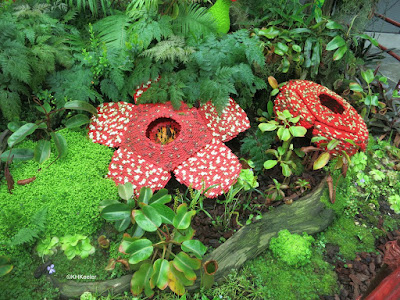For example these Nepenthes pitchers, seen in Seattle's Volunteer's Park Conservatory. About five inches long, the pitchers capture and digest insects to provide essential nutrients for the plant. Carnivorous plants are most diverse in low-nutrient ecosystems such as tropical bogs.
So I was pleased to see Nepenthes pitchers at the Gardens by the Bay in Singapore.
But wait! those aren't plants, those are built from legos!
They were growing the real thing, both the little green ones below the big plastic ones in the photo above and larger pitchers in the photo below:
But somebody had a wonderful time constructing insectivorous plants in legos.
For example, this Venus flytrap, a spectacular carnivorous plant in one of the biggest families of insectivorous plants, the Droseraceae.
(Pick out the model plants from the real ones in the photo above.)
Below, real Venus flytraps, much smaller than the model. Note the red lining in their insect traps, none quite as gaping as the big model above. When an insect walks on those leaves, it is likely to bump a tiny hair (white in the model) which triggers the leaf to close, imprisoning the insect. The leaf then digests the insect. The Venus flytrap has one of the most dramatic movements of any plant (see video). Venus flytraps are a single species, Dionaea muscipula, only found in eastern North America (link).
 |
| Venus flytraps, Dionaea muscipula |
The Nepenthes pitchers in the first photo of this post are about as big as carnivorous plants get. Most are quite small, like the ones below, from a bog in western Oregon, not more than a few inches at the tallest. They live in areas where nutrients, especially nitrogen, are limiting, whether hanging from a tree in Borneo or floating atop a bog in Oregon. Digesting the occasional insect allows survival but its still a difficult life-style. Most are rare and so exciting to see alive, let alone in nature.
 |
| pitcher plants in Oregon |
I loved the whimsy.
What plants would you build with an afternoon and boxof legos?
Previous post about Gardens by the Bay in Singapore.
Comments and corrections welcome.
References
Botanical Society of America. Carnivorous Plants. link
Discovery.com Venus flytrap video video
Learn about Nature. Carnivorous plants link
Kathy Keeler, A Wandering Botanist
More at awanderingbotanist.com






No comments:
Post a Comment